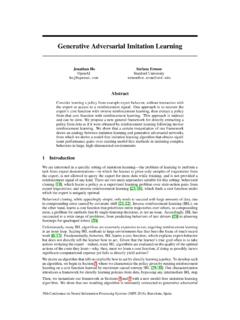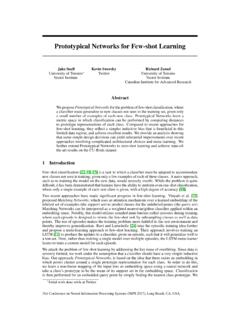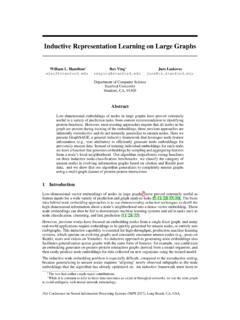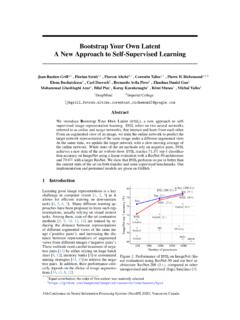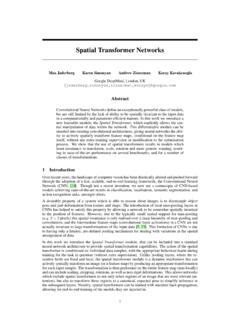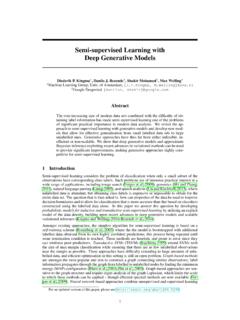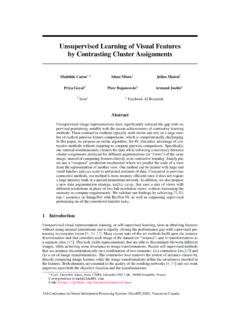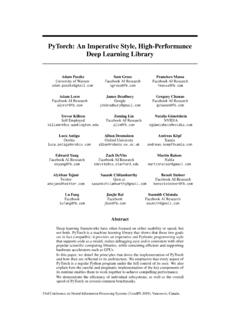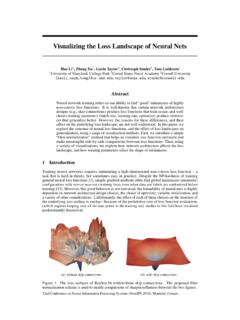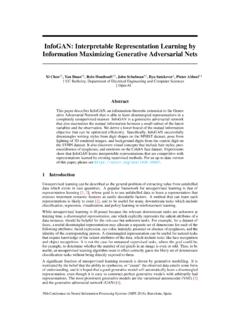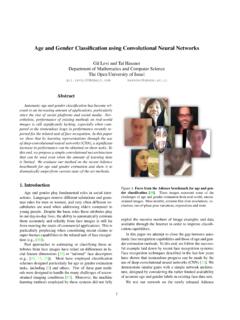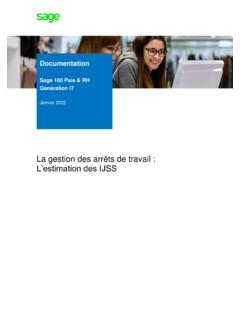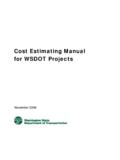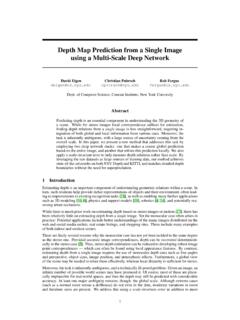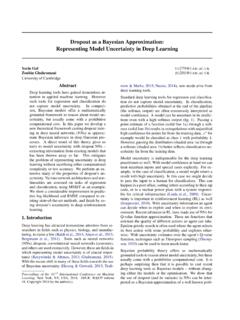Transcription of Simple and Scalable Predictive Uncertainty Estimation using …
1 Simple and Scalable Predictive Uncertainty Estimation using Deep Ensembles Balaji Lakshminarayanan Alexander Pritzel Charles Blundell DeepMind Abstract Deep neural networks (NNs) are powerful black box predictors that have recently achieved impressive performance on a wide spectrum of tasks. Quantifying pre- dictive Uncertainty in NNs is a challenging and yet unsolved problem. Bayesian NNs, which learn a distribution over weights, are currently the state-of-the-art for estimating Predictive Uncertainty ; however these require significant modifica- tions to the training procedure and are computationally expensive compared to standard (non-Bayesian) NNs.
2 We propose an alternative to Bayesian NNs that is Simple to implement, readily parallelizable, requires very little hyperparameter tuning, and yields high quality Predictive Uncertainty estimates. Through a series of experiments on classification and regression benchmarks, we demonstrate that our method produces well-calibrated Uncertainty estimates which are as good or better than approximate Bayesian NNs. To assess robustness to dataset shift, we evaluate the Predictive Uncertainty on test examples from known and unknown distributions, and show that our method is able to express higher Uncertainty on out-of-distribution examples.
3 We demonstrate the scalability of our method by evaluating Predictive Uncertainty estimates on ImageNet. 1 Introduction Deep neural networks (NNs) have achieved state-of-the-art performance on a wide variety of machine learning tasks [35] and are becoming increasingly popular in domains such as computer vision [32], speech recognition [25], natural language processing [42], and bioinformatics [2, 61]. Despite impressive accuracies in supervised learning benchmarks, NNs are poor at quantifying Predictive Uncertainty , and tend to produce overconfident predictions. Overconfident incorrect predictions can be harmful or offensive [3], hence proper Uncertainty quantification is crucial for practical applications.
4 Evaluating the quality of Predictive uncertainties is challenging as the ground truth' Uncertainty estimates are usually not available. In this work, we shall focus upon two evaluation measures that are motivated by practical applications of NNs. Firstly, we shall examine calibration [12, 13], a frequentist notion of Uncertainty which measures the discrepancy between subjective forecasts and (empirical) long-run frequencies. The quality of calibration can be measured by proper scoring rules [17] such as log Predictive probabilities and the Brier score [9]. Note that calibration is an orthogonal concern to accuracy: a network's predictions may be accurate and yet miscalibrated, and vice versa.
5 The second notion of quality of Predictive Uncertainty we consider concerns generalization of the Predictive Uncertainty to domain shift (also referred to as out-of-distribution examples [23]), that is, measuring if the network knows what it knows. For example, if a network trained on one dataset is evaluated on a completely different dataset, then the network should output high Predictive Uncertainty as inputs from a different dataset would be far away from the training data. Well-calibrated predictions that are robust to model misspecification and dataset shift have a number of important practical uses ( , weather forecasting, medical diagnosis).
6 31st Conference on Neural Information Processing Systems (NIPS 2017), Long Beach, CA, USA. There has been a lot of recent interest in adapting NNs to encompass Uncertainty and probabilistic methods. The majority of this work revolves around a Bayesian formalism [4], whereby a prior distribution is specified upon the parameters of a NN and then, given the training data, the posterior distribution over the parameters is computed, which is used to quantify Predictive Uncertainty . Since exact Bayesian inference is computationally intractable for NNs, a variety of approximations have been developed including Laplace approximation [40], Markov chain Monte Carlo (MCMC).
7 Methods [46], as well as recent work on variational Bayesian methods [6, 19, 39], assumed density filtering [24], expectation propagation [21, 38] and stochastic gradient MCMC variants such as Langevin diffusion methods [30, 59] and Hamiltonian methods [53]. The quality of Predictive Uncertainty obtained using Bayesian NNs crucially depends on (i) the degree of approximation due to computational constraints and (ii) if the prior distribution is correct', as priors of convenience can lead to unreasonable Predictive uncertainties [50]. In practice, Bayesian NNs are often harder to implement and computationally slower to train compared to non-Bayesian NNs, which raises the need for a general purpose solution' that can deliver high-quality Uncertainty estimates and yet requires only minor modifications to the standard training pipeline.
8 Recently, Gal and Ghahramani [15] proposed using Monte Carlo dropout (MC-dropout) to estimate Predictive Uncertainty by using Dropout [54] at test time. There has been work on approximate Bayesian interpretation [15, 29, 41] of dropout. MC-dropout is relatively Simple to implement leading to its popularity in practice. Interestingly, dropout may also be interpreted as ensemble model combination [54] where the predictions are averaged over an ensemble of NNs (with parameter sharing). The ensemble interpretation seems more plausible particularly in the scenario where the dropout rates are not tuned based on the training data, since any sensible approximation to the true Bayesian posterior distribution has to depend on the training data.
9 This interpretation motivates the investigation of ensembles as an alternative solution for estimating Predictive Uncertainty . It has long been observed that ensembles of models improve Predictive performance (see [14] for a review). However it is not obvious when and why an ensemble of NNs can be expected to produce good Uncertainty estimates. Bayesian model averaging (BMA) assumes that the true model lies within the hypothesis class of the prior, and performs soft model selection to find the single best model within the hypothesis class [43]. In contrast, ensembles perform model combination, they combine the models to obtain a more powerful model; ensembles can be expected to be better when the true model does not lie within the hypothesis class.
10 We refer to [11, 43] and [34, ] for related discussions. It is important to note that even exact BMA is not guaranteed be robust to mis-specification with respect to domain shift. Summary of contributions: Our contribution in this paper is two fold. First, we describe a Simple and Scalable method for estimating Predictive Uncertainty estimates from NNs. We argue for training probabilistic NNs (that model Predictive distributions) using a proper scoring rule as the training criteria. We additionally investigate the effect of two modifications to the training pipeline, namely (i) ensembles and (ii) adversarial training [18] and describe how they can produce smooth Predictive estimates.
